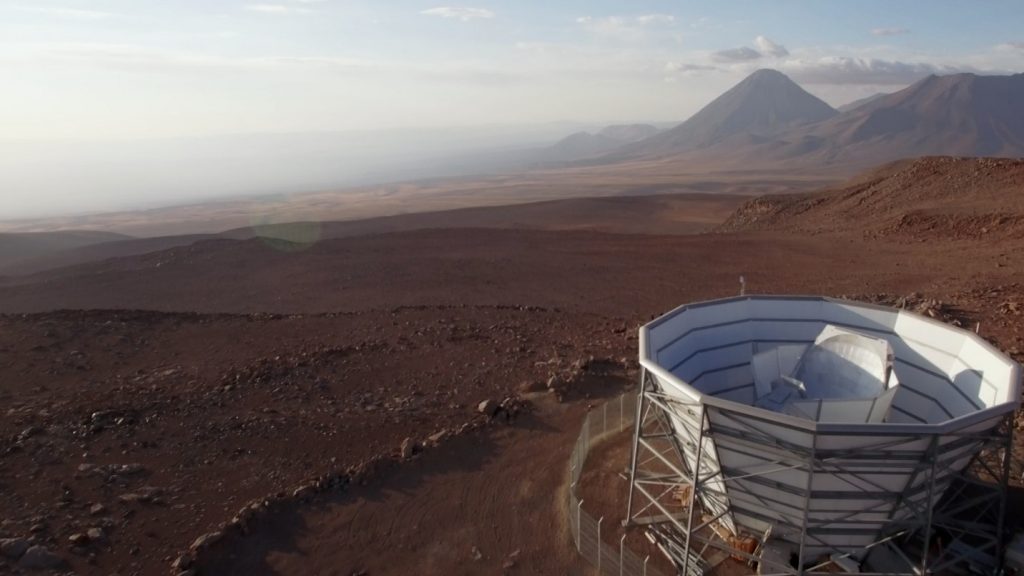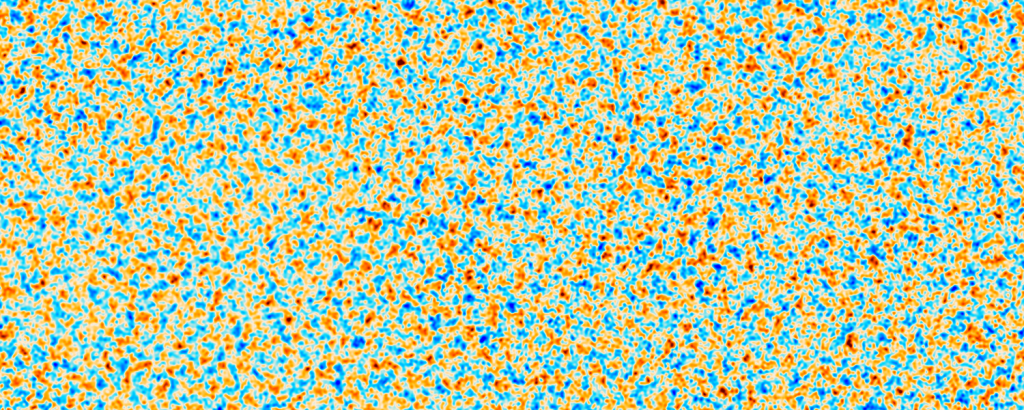The Hubble Trouble is not a CMB one according to major new Atacama Cosmology Telescope results: The Deep Universe Tension with the Nearby Universe continues

The Atacama Cosmology Telescope measures the oldest light in the universe, known as the cosmic microwave background. Using those measurements, scientists can calculate the universe’s age. Credit: Debra Kellner

A portion of a new picture of the oldest light in the universe taken by the Atacama Cosmology Telescope. This part covers a section of the sky 50 times the moon’s width, representing a region of space 20 billion light-years across. The light, emitted just 380,000 years after the Big Bang, varies in polarization (represented here by redder or bluer colors). Astrophysicists used the spacing between these variations to calculate a new estimate for the universe’s age. Credit: ACT Collaboration
From a mountain high in Chile’s Atacama Desert, astronomers with the National Science Foundation’s Atacama Cosmology Telescope (ACT) have taken a fresh look at the oldest light in the universe. Their new observations plus a bit of cosmic geometry suggest that the universe is 13.77 billion years old, give or take 40 million years.
The new estimate matches the one provided by the standard model of the universe and measurements of the same light made by the Planck satellite. This adds a fresh twist to an ongoing debate in the astrophysics community, says Simone Aiola, first author of one of two new papers on the findings posted to arXiv.org. In 2019, a research team measuring the movements of galaxies calculated that the universe is hundreds of millions of years younger than the Planck team predicted. That discrepancy suggested that a new model for the universe might be needed and sparked concerns that one of the sets of measurements might be incorrect.
“Now we’ve come up with an answer where Planck and ACT agree,” says Aiola, a researcher at the Flatiron Institute’s Center for Computational Astrophysics in New York City. “It speaks to the fact that these difficult measurements are reliable.”
The age of the universe also reveals how fast the cosmos is expanding, a number quantified by the Hubble constant. The ACT measurements suggest a Hubble constant of 67.6 kilometers per second per megaparsec. That means an object 1 megaparsec (around 3.26 million light-years) from Earth is moving away from us at 67.6 kilometers per second due to the expansion of the universe. This result agrees almost exactly with the previous estimate of 67.4 kilometers per second per megaparsec by the Planck satellite team, but it’s slower than the 74 kilometers per second per megaparsec inferred from the measurements of galaxies.
“I didn’t have a particular preference for any specific value — it was going to be interesting one way or another,” says Steve Choi of Cornell University, first author of the other paper posted to arXiv.org. “We find an expansion rate that is right on the estimate by the Planck satellite team. This gives us more confidence in measurements of the universe’s oldest light.”
Dick Bond at Canadian Institute of Theoretical Astrophysics (CITA) explained that the new ACT DR4 data release represents a major step forward in explorations of the cosmic microwave background at high resolution, much beyond what we were able to do with the Planck satellite. He further explains: “Among the many exquisite results characterizing the state of the cosmos, in particular on how it appeared 380000 years after the Big Bang, some 13.8 +- , 04 billion years ago according to ACT, in agreement with Planck, is the much anticipated result on this age and the related rate of expansion of the universe, both agreeing with at the same precision level with Planck in completely independent experiments and analysis.” This further deepens the mystery that has been raging for a number of years in cosmology, of why nearby astronomical estimates of the expansion rate differ from ACT and Planck: “is it new fundamental physics, e.g., involving radical ideas about the dark energy that now dominates the dynamics of the universe? Now we know definitively that it is not an issue with the CMB value.”
Like the Planck satellite, ACT peers at the afterglow of the Big Bang. This light, known as the cosmic microwave background (CMB), marks a time 380,000 years after the universe’s birth when protons and electrons joined to form the first atoms. Before that time, the cosmos was opaque to light.
If scientists can estimate how far light from the CMB traveled to reach Earth, they can calculate the universe’s age. That’s easier said than done, though. Judging cosmic distances from Earth is hard. So instead, scientists measure the angle in the sky between two distant objects, with Earth and the two objects forming a cosmic triangle. If scientists also know the physical separation between those objects, they can use high school geometry to estimate the distance of the objects from Earth.
Subtle variations in the CMB’s glow offer anchor points to form the other two vertices of the triangle. Those variations in temperature and polarization resulted from quantum fluctuations in the early universe that got amplified by the expanding universe into regions of varying density. (The denser patches would go on to form galaxy clusters.) Scientists have a strong enough understanding of the universe’s early years to know that these variations in the CMB should typically be spaced out every billion light-years for temperature and half that for polarization. (For scale, our Milky Way galaxy is about 200,000 light-years in diameter.)
ACT measured the CMB fluctuations with unprecedented resolution, taking a closer look at the polarization of the light. “The Planck satellite measured the same light, but by measuring its polarization in higher fidelity, the new picture from ACT reveals more of the oldest patterns we’ve ever seen,” says Suzanne Staggs, ACT’s principal investigator and the Henry deWolf Smyth Professor of Physics at Princeton University.
As ACT continues making observations, astronomers will have an even clearer picture of the CMB and a more exact idea of how long ago the cosmos began. The ACT team will also scour those observations for signs of physics that doesn’t fit the standard cosmological model. Such strange physics could resolve the disagreement between the predictions of the age and expansion rate of the universe arising from the measurements of the CMB and the motions of galaxies.
“We’re continuing to observe half the sky from Chile with our telescope,” says Mark Devlin, ACT’s deputy director and the Reese W. Flower Professor of Astronomy and Astrophysics at the University of Pennsylvania. “As the precision of both techniques increases, the pressure to resolve the conflict will only grow.”
The ACT team is an international collaboration, with scientists from 41 institutions in seven countries. At the University of Toronto, members of CITA (the Canadian Institute for Theoretical Astrophysics), DI (the Dunlap Institute for Astronomy & Astrophysics) and DADDAA (the David A. Dunlop Department of Astronomy and Astrophysics) play essential roles in ACT, through the significant contributions over many years: by many CITAzens in ACT, CITA Professor Dick Bond, Mike Nolta (now SciNet), Jon Sievers (now McGill professor), Nick Battaglia (now Cornell professor), Zhiqi Huang (now Sun Yat Sen professor and Dean), Amir Hajian (now Thompson Reuters), Eric Switzer (NASA Goddard), Hy Trac (now Carnegie Mellon professor), Alex van Engelen (now Arizona professor), Adam Hincks (now UofT professor), and Martine Lokken (currently a joint CITA and Dunlop Institute graduate student); Professor Renee Hlozek of DADDAA and the Dunlop Institute and her group, including Martine, and Professor Adam Hincks of DADDAA. The entire ACT collaboration has benefited enormously from the huge supercomputing computational power of SciNet at Toronto, awarded by Compute Canada to CITA, allowing much of the processing from raw data to maps and then to final cosmic parameters to be done.
Many CITAzens have also been involved in the Planck satellite consortium, including Professors Bond and Martin at CITA, Marc Antoine Miville Deschenes (Saclay faculty), Olivier Dore (JPL faculty), Zhiqi Huang, Daan Meerburg (Groningen faculty), Mike Nolta, ex-graduate student Marzieh Fahrang (faculty in Tehran), and Professor Barth Netterfield and Brendan Crill (JPL faculty) of DADDAA and Physics.
According to Dick Bond of the Canadian Institute for Theoretical Astrophysics in Toronto “For almost a decade SciNet and Compute Canada has delivered annually a large allocation of computing cycles for the ACT experiment to us that has been essential in processing maps of the cosmic background universe from the voluminous raw data that we have obtained from the Chile-based ACT telescope. These cycles have been used by many of us involved in Toronto over the years, but also by many team members in the US and elsewhere: the ACT project could not have proceeded without access to such powerful computing resources. This newest ACT release include an extremely important result on the rate of expansion of the universe that is completely independent but in excellent agreement with that derived from the Planck satellite (for which we also used SciNet for analysis). It further deepens the mystery that has been raging for a few years in cosmology, of why nearby astronomical estimates of the expansion rate differ from ACT and Planck: is it new fundamental physics, e.g., involving radical ideas about the dark energy that now dominates the dynamics of the universe? The cosmic background results have now been shown to be completely solid with this new ACT data.”
A brief description of Compute Canada’s mission from Roohi Shaikh and Mike Nolta of SciNet “SciNet is a high-performance computing facility that houses Canada’s largest supercomputer centre, Niagara. It provides Canadian researchers with computational resources and expertise necessary to perform their research on scales not previously possible in Canada and helps power research and training across a broad range of disciplines. SciNet also provides resources for Compute/Calcul Canada, a national infrastructure for supercomputing-powered research. It is funded by the Canada Foundation for Innovation, the Government of Ontario, and the University of Toronto.”
Three papers on ACT DR4 with the important scientific results are appearing today Wednesday July 15 on the ArXiv, have been submitted to the Journal of Cosmology and Astroparticle Physics, and are also here on the ACT website.
Read more about it in the news: